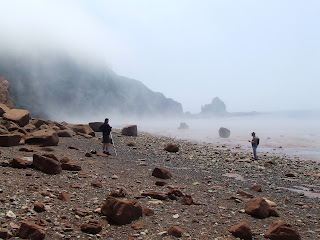Five Islands Provincial Park (2012)
Here's another of my belated posts on one of my trips last year. Me and my buddy Craig went for one of many trips to the beautiful town of Parrsboro, Nova Scotia. From town, we headed East towards the small village of Five Islands, which has a Provincial park of the same name: Five Islands Provincial Park.
Islands from right to left: Moose i., Diamond i.,
Long i., Pinnacle i., Egg i., Pinnacle rock
Five Islands Provincial Park is a location that has witnessed several events, including a major extinction. Most of the rocks South of the park, towards Red Head and continuing on to Lower Economy, are of a red sandstone from the Triassic Period. These red sandstones from around Red Head are indicative of an arid, desertic climate. On top of the Triassic rock is a layer that corresponds to the Triassic-Jurassic boundary, sandwiched between Triassic sandstone and Jurassic basalts right on top of it. This Triassic-Jurassic layer is identified by its white sandstone and mudstone. The importance of this layer is that it represents one of the major extinction events that had occurred at the boundary. It is still being studied today.
The basalts that top these sandstone layers South of the park and protrude West and created the islands, are of the same found at Blomidon and Cape d'Or. These Jurassic age ancient lava flows and dykes could have been part of an active volcanic network seen all over the Minas Basin. The Old Wife is a result of this contorted, violent past. The islands which dot the landscape are also mostly composed of this Jurassic basalt, and some sections of Jurassic sandstones.
"Old Wife", with Moose Island in the background
The red cliffs just North of the basalt and separated by faults is of Jurassic age. Dinosaur tracks and other fossils have been found occasionally from either the cliff face, or from loose rocks on the beach. A local by the name of Eldon George had found, among many other wonderful fossils, the smallest dinosaur tracks ever found back in the 1980s at Wasson's Bluff, sandstones of the same age and formation not too far from here. See Jon Tattrie's article.
Water channel comprised of multiple layers (organic)
Jurassic McCoy Brook Frm. (left),
Jurassic North Mountain Frm. (right)
But I digress, as I keep rambling on the technical and less on the practical. We arrived at the park when the tide was going down. We walked down the beach and was met with a thick band of fog that was going out the bay.
Lava flows
Heading South after searching the beach for agate and fossil fragments, the fog lifted and the Sun came out. We went around the Old Wife and headed towards Red Head.
Fault running through columnar basalt
Beach made up of basalt and minerals
"Red Head", seperating the Triassic-Jurassic Blomidon Frm.
(West) and Triassic Wolfville Frm. (East)
Triassic Wolfville Frm. red sandstone cliffs
Modern day trackways (crab)
This area is only accessible at extreme low tide, so the window of opportunity is very small. Getting trapped or stranded is a very highly probable so good planning and looking up the tide charts before heading down this way is an ABSOLUTE MUST!
This is one of the places in Nova Scotia that I highly recommend visiting, among other sites of course. =)
Disclaimer: In Nova Scotia under the 'Special Places Protection Act', fossils cannot be dug up or disturbed without a permit. The province has a mandate to protect palaeontological sites and it is your civic duty to report any finds to the local museum, or the Department of Communities, Culture and Heritage (https://cch.novascotia.ca/exploring-our-past/special-places). This encourages the contribution these finds could make to science not just in the provice, but on the global stage. You must also seek permission if you are to enter private land.




















